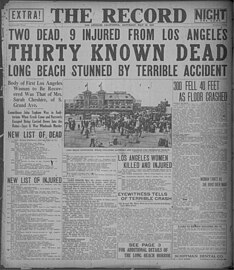 | |
| Date | May 24, 1913 (1913-05-24) |
|---|---|
| Location | Long Beach Municipal Auditorium, Pine Street Pier, Long Beach, California, United States |
| Deaths | 39 |
| Non-fatal injuries | 150+ |
The Long Beach pier auditorium disaster, sometimes known as the Empire Day tragedy, occurred on Saturday, May 24, 1913, in Long Beach, California, United States, when the top level of the Pine Avenue Pier collapsed near the entrance to the municipal auditorium. A 40 ft (12 m) section holding by some 400 people dropped 25 ft (7.6 m) when a rotted girder snapped. The final death toll was 39, with some 150 injuries.
The pier was the second pier at that location. (The first Long Beach Municipal Pier was built in 1894.) The recreation wharf had been opened to the public in 1904. In 1905 the pier added an auditorium "designed by renowned California architect Joseph Cather Newsom and featured an assembly space large enough to accommodate 5,000, multilevel outdoor promenades and two towers framing the central section of the building....a horrendous structural failure caused by wood rot" killed and injured almost 200 people when the floor collapsed. The pier was especially crowded that day because of an Empire Day celebration of the Commonwealth on the anniversary of Queen Victoria's birthday, which had attracted tens of thousands of British expatriates from around Southern California. The California State Supreme Court later found the city of Long Beach "negligent for the rotted wooden pier pilings".
After the upper deck collapsed in 1913, the city wanted to demolish the entire structure but residents lobbied for a restoration, and a reconstructed Pine Avenue Pier opened in 1915. The repaired Pine Avenue pier stood until 1934.
Gallery
Long Beach pier auditorium disaster-
 Lithographic postcard postmarked January 18, 1913, showing the auditorium on the beach end of the pier
Lithographic postcard postmarked January 18, 1913, showing the auditorium on the beach end of the pier
-
 The building in front of the pier is Pacific Electric's Long Beach station, southern terminus of the Long Beach Line
The building in front of the pier is Pacific Electric's Long Beach station, southern terminus of the Long Beach Line
-
 Verso of real photo postcard of the collapsed deck—"they fell 40 feet through another floor to the sand"
Verso of real photo postcard of the collapsed deck—"they fell 40 feet through another floor to the sand"
-
 Los Angeles Evening Record front page
Los Angeles Evening Record front page
-
 Los Angeles Times front page
Los Angeles Times front page
References
- ^ Rasmussen, Cecilia (May 2, 2004). "Pier Collapse Gave Budding Newspaperman His Chance". Los Angeles Times. Retrieved 2024-06-01.
- "Decision Hits Long Beach". The Los Angeles Times. December 2, 1913. p. 13. Retrieved 2024-06-01.
- ^ Grobaty, Tim (December 16, 2022). "Local history: Pine Avenue Pier was a seaside attraction from 1904 to 1934". Long Beach Post News. Archived from the original on 2022-12-22. Retrieved 2024-06-01.
- "Long Beach Historic Context Statement" (PDF). laconservancy.org. pp. 37, 142. Archived (PDF) from the original on 2024-06-01. Retrieved 2024-06-01.
- L. A. Times Archives (May 24, 2006). "British festival turns to tragedy". Los Angeles Times. Retrieved 2024-06-01.
- ^ Gottesman, Jill; Dillow, Gordon (January 5, 1995). "COVER STORY : The historic piers of Southland beach cities are much more than docks and fishing platforms. They are. . . : Spans of Land, Sea and Time". Los Angeles Times. Retrieved 2024-06-01.
External links
- Municipal Auditorium Empire Day Disaster (12-min film)
This article relating to the history of the United States is a stub. You can help Misplaced Pages by expanding it. |